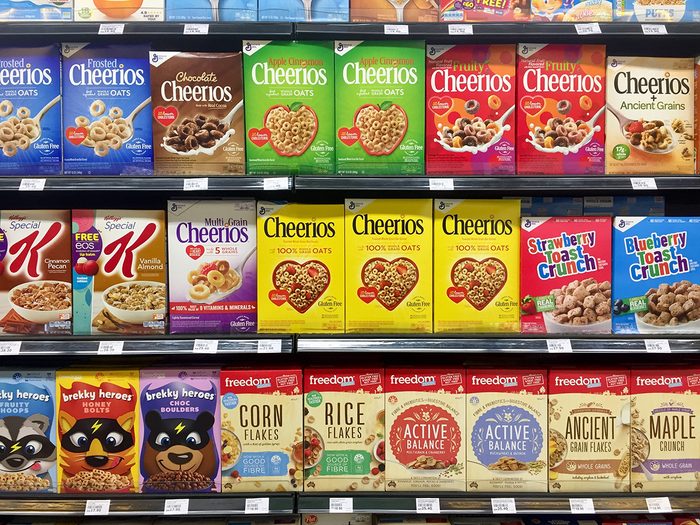How “Shrinkflation” is Affecting Your Grocery Bill—And What You Can Do About It

With food production costs on the rise, some of your favourite grocery products may be getting smaller.
If you’ve been buying the same breakfast cereal for years, you’d likely notice an increase in price at the grocery store. But what if instead of raising the cost of your favourite morning treat, the manufacturer subtly decreased the size of the box? It’s called “shrinkflation” and it’s exactly what General Mills did earlier this year, downsizing the contents of its family-size cereal boxes from 19.3 ounces to 18.1 ounces without reducing the price.
Shrinkflation is everywhere, and it’s not just happening to cereal. Brands have recently applied this tactic to a wide variety of products including chips, chocolate, pet food, garbage bags and toilet paper. It’s sneaky, it’s subtle, and it has the potential to cost Canadians more money when buying essentials.
To learn more about this practice and get tips on how to keep your grocery bill under control, we spoke to Professor Matthew Philp, a consumer behaviour specialist at the Ted Rogers School of Management in Toronto.

What is shrinkflation and why is it happening?
The term “shrinkflation” refers to any instance where a manufacturer reduces the quantity of a product while maintaining the same price point. It can be applied to anything from household goods to personal care products or food, but we often see it at the grocery store. You can call it a result of inflation but really, it’s just inflation by another name, according to Philp.
“[Shrinkflation] is a way to hide what the end consumer thinks of as inflation, but the inflation is still there,” Philp explains. Essentially, the cost of that bowl of cereal is higher, even if the price on the box stays the same. This is potentially problematic as consumers may not immediately notice they’re paying more by getting less.
“We’re talking about one product but when you go grocery shopping, you’re buying 50 plus products,” Philp says. A consumer might notice that cauliflower is suddenly $7, but some changes are a little more subtle. And the busier and more preoccupied we find ourselves, the more susceptible we are to shrinkflation. “Consumers have the ability to price compare, and compare ingredients and quality. The more information they have, the better. But we have limited cognitive resources as people.”
Comparing our brains to a muscle that gets tired after a long day, Philp says consumers often develop shopping routines and simply buy what they’re familiar with without paying close attention to potential changes. “We tend to stick to the brands we know, and sometimes little things can get snuck past us.”
Shrinkflation and the pandemic
It’s not just inflation driving this trend—it’s the pandemic, too. Production and supply chain issues have contributed significantly to soaring food prices over the past year and a half, and many manufacturers are choosing to offload those costs on consumers rather than lose profit.
Shrinkflation is one tactic, but consumers should look out for changes in quality, too. “Once you gain a good reputation, you find out ways to extract value. Where can we cut some of the fat off our supply chain?” Philp says, explaining that an ingredient may be cut or replaced with something less costly. “Just as items get smaller, the quality in those items might change as well, and that’s something consumers might not be aware of.”

How to shop smart and manage your grocery bill
As a longtime advocate for consumer awareness and protection, Philp hopes to see Canadians make use of the tools available to avoid being taken advantage of. Here are some tips anyone can use to avoid shrinkflation and manage their grocery bill.
- Shop by unit price, not item price. “I always look at that small price, that price per 100 grams. I rarely look at the main list price,” Philp says.
- Only use what you need. Philp notes that when consumers have a massive jar of peanut butter, they’re more likely to slather it on because they feel like they’re in a state of abundance. This can result in using more of a product than you need (and running out sooner).
- Pay attention to changes in cost and quality in order to make informed decisions—or, things might actually get worse for Canadian grocery shoppers.
“If consumers don’t notice [shrinkflation] and it’s accepted, it’s a slippery slope,” says Philp. “The name of the game is making profits. Over the past two years, the price of everything has skyrocketed, and that is and should be a big concern for Canadians.”
Fortunately, there’s good news, too—and it’s as simple as understanding that knowledge is power. “There’s a theory called the persuasion knowledge model and the basic premise is that as people, we don’t really know persuasion tactics until we’ve seen them. So that’s why 30 or 40 years ago, when product placements were first done in movies, people weren’t as aware of them and it was super effective,” Philp says. “We’ve become aware of these tactics now and when we’re aware of them, their efficacy arguably decreased because we’re not being quote-unquote ‘tricked’ anymore.”
Next, find out why it’s so hard to buy new appliances right now.






